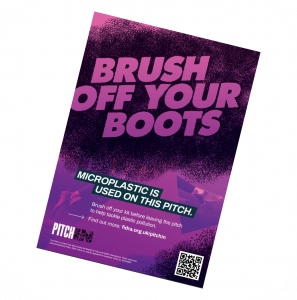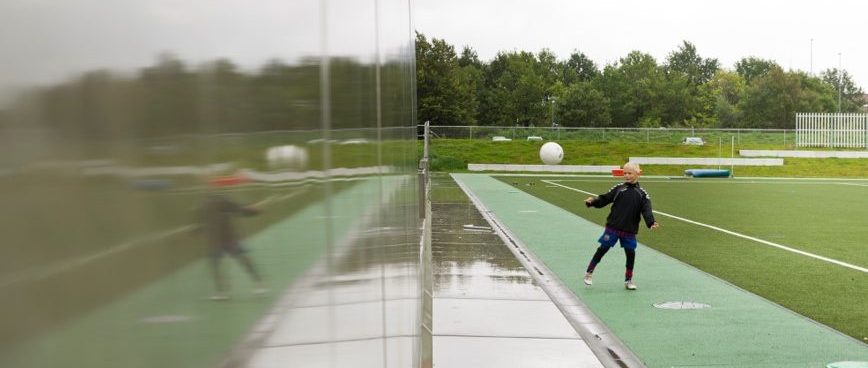Sign our Pitch In Pledge
Join us in calling for action to prevent microplastic pollution from 3G sports pitches:
‘I am signing the Pitch In Pledge because I am concerned about microplastic pollution from 3G sports pitches. I want to see more done to prevent losses of microplastic to the environment and join the call for everyone from pitch designers to local football clubs to tackle microplastic loss from pitches. I pledge to take action to reduce microplastic. This means taking care to prevent spreading of microplastic when I use the pitch, and raising awareness with my wider pitch community.’
Who can sign?
Anyone can sign this pledge.
You can sign up as an industry representative, club, school, community group or individual. Just let us know who you represent on the form.
Why are we asking people to sign our pledge?
We are asking you to sign our pledge to show support for this issue. We want to show that people across the UK care about microplastic pollution from pitches and are calling for action.
Your signature supports our calls for changes to design, construction and management of 3G pitches which will prevent plastic pollution.
What happens next?
Once you’ve signed the pledge, you’ll be taken to a thank you page where all our resources for tackling microplastic loss from pitches can be downloaded free of charge. We’ll send you an e-mail to welcome you to team Pitch In and we would love to keep in touch to find out how you are tackling microplastic loss from pitches. If you have asked for your pitch or club to be added to our map, we’ll add an icon to show you’re taking part.
Quick Activities
Have 2 minutes after practice? Or some spare time on a rainy day? Try these activities and show your support for tackling microplastic pollution! Tell us you’re taking part on facebook and twitter @FidraTweets using #teampitchin
 Put up a poster
Put up a poster
Encourage your team mates to brush off their boots and tackle microplastic pollution. Our posters are great for putting up next to the pitch or in a changing room and can be downloaded for free, all you need to do is print it out and pin it up.
The Wibble Wobble Warm Down!
The Wibble Wobble Warm Down!
Use our wibble wobble warm down to shake, brush and wobble off any infill clinging onto your kit!
- Shake your arms and legs, starting at your feet and hands and ending up at your hips and shoulders. Yes, it’s supposed to look silly!
- Use your hands to give your legs and arms a quick brush down.
- Don’t forget to brush off and shake out your boots before leaving the pitch! (and wash your hands when you’re done playing).
Can you spread the joy of the wibble wobble warm down? Can you get your favourite player, or team mascot, to do some silly moves to support our project? Share a video or GIF with us on twitter, Instagram or facebook using #teampitchin @Fidratweets @Kimoint
Design a Poster
Design a Poster!
Use your creative talents and let you mind run free. Why not design and create your very own poster? You could design it to help let people know that microplastic comes from 3G pitches or it could focus on what people can do to help. You can then put it up on your local pitch or in your school. Use our poster for inspiration if you are stuck. Check out our problem page for all the information you need to help you create the perfect poster.
When you’re finished, send your designed poster to info@fidra.org.uk with the subject ‘PITCH IN POSTER’ and we will make sure to put it up in an online gallery!
Remember to include your first name and your local town or club.
Share you poster with us on social media too, by tagging us on Twitter or Facebook using #PitchIn @fidratweets
The Pitch In Games
We’ve created some fun activities that can be used to explore the microplastics problem on your own pitch.
These games have been developed with schools or youth groups in mind but can be used by any team or group of friends. Use them to raise awareness of the issue and involve young people in understanding the problem.
Hover on the squares below to find out more about each activity:
Find the Microplastic!
This activity will help you carry out some careful detective work to find out how and where microplastic is coming off your pitch
Shake it Out
A fun way to see how much rubber crumb is coming off you and your team-mates as you leave the pitch
What's on your Kit?
Take this quiz home to find out how much rubber crumb makes it into your kit each week
Design a Poster!
Get creative by designing a poster to impress your teammates and share your knowledge
Take action! Write to your Local Pitch
Calling for bigger changes
If the pitch you play on uses microplastic infill, you may already be doing your bit by brushing off your boots or trying our wibble wobble warm down!
But to tackle all pathways of microplastic loss bigger changes are needed, these changes need the support of the pitch owners.
To get support for these changes, you can write to your pitch owner or manager to let them know that you want to see action on your local pitch. Write your own letter or use our template to promote Fidra’s Pitch In project and encourage pitch owners to take action.

How can I do this?
See our advice on the right on writing a great letter to your local pitch owner. Or you can download and edit our Letter Template:
What if I don’t know who owns my pitch?
In the UK artificial pitches are often owned by the local council, although they might be managed by a private company or your local school/university. If you’re struggling to work out who to write to, get in touch with us and we can help you to find a contact: info@team-pitch.in
How to write a good letter
Here are some tips on what to include when writing your letter
Start with essential info
-
- Add your name and address in the top right corner
- Make sure to put the name / club name and location of your 3G pitch
- Start by addressing the owner (by name, company or school)
- Add some information about you: who you are, when do you use the pitch
Outline the problem
-
- Add some information about the problem of microplastic pollution – why are you worried about it? You can find out more on our problems page
- Add details of your pitch – have you seen bits of microplastic around the edge of the pitch
- Have you completed any of the other Pitch In activities? Tell the pitch owner what you found!
Ask for solutions
-
- Tell them what changes you want to see
- Make sure you include this link to our guidelines that are free to download www.fidra.org.uk/artificial-pitches/cleaner-pitch-guidelines
- If you’re writing to your local authority, you can include this link https://bit.ly/37r4Cbg to our briefing.
Sign off
-
- Thank the reader for their time, include your email or telephone contact details so they can get in touch
- Sign the letter
Useful resources for letter writing:
Pitch In Map
Have you signed our pledge? Have you downloaded our Pitch In Posters? Maybe you are doing something else to help combat microplastic pollution from your local 3G pitch?
Let us know! Add your details to our Pitch In map to share with the wider Pitch In community and help us promote your efforts.
This interactive map shows the clubs, community groups, schools and individuals who are taking part in our project to tackle microplastic lost from pitches. Why not click on an icon to find out what Team Pitch In has already achieved?
